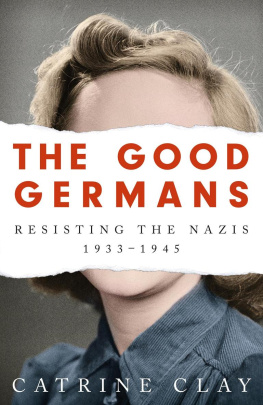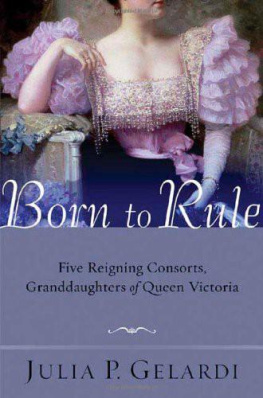Copyright 2006 by Catrine Clay
All rights reserved. No part of this book may be used or reproduced in any manner
whatsoever without written permission from the publisher except in the case of brief quotations embodied in critical articles or reviews.
For information address Walker & Company, 104 Fifth Avenue, New York, New York 10011.
Published by Walker Publishing Company, Inc., New York
Distributed to the trade by Holtzbrinck Publishers
All papers used by Walker & Company are natural, recyclable products made from wood
grown in well-managed forests. The manufacturing processes conform to the environmental regulations of the country of origin.
L IBRARY OF C ONGRESS C ATALOGING-IN- P UBLICATION D ATA HAS BEEN APPLIED FOR.
eISBN: 978-0-802-71883-9
Visit Walker & Company's Web site at www.walkerbooks.com
First published in Great Britain by John Murray, a division of Hodder Headline
First U.S. Edition 2007
3 5 7 9 1 0 8 6 4 2
Typeset by Servis Filmsetting Ltd, Manchester, UK
Printed in the United States of America by Quebecor World Fairfield
For John, naturally
Contents
The author and publishers wish to thank the following for permission to reproduce illustrations: 1, 2, 3, 5, 8, 11, 13, 14, 15, 19, 21, 22, 23, 27, 29, and 32, Her Majesty Queen Elizabeth II; 4, 12, 16, 18, 24, 25 and 33, GARF; 6, 7, 17, 28 and 31, Getty Images; 9, John Murray; 26 and 35, private; 10, Donaueschingen; 20, Bulow; 30, Grabbe.
I am most grateful to Her Majesty Queen Elizabeth II for permission to quote from the letters of King George V, Kaiser Wilhelm II and Tsar Nicholas II, as well as the diaries of George V, both before and after he became King. The three cousins, Georgie, Willy and Nicky, wrote to one another regularly right up to and including the First World War, freely mixing political comment with the usual gossip of family life; indeed, it is often hard to tell the difference. Without this special access to their private letters this book could not have been written in the form it now takes. I am equally indebted to Her Majesty for allowing me to reproduce a selection of photographs from the Royal Collection, and examples of the actual letters from one royal cousin to the other, allowing us to study handwritings and signatures. I would like to take this opportunity to thank the staff at the Royal Archives. Pamela Clark, the Registrar, Jill Kelsey, who had the arduous task of checking my numerous quotes, and Lisa Heigh way, who helped to locate the many illustrations, were all unfailingly generous with their expert help.
My thanks otherwise can best be expressed in chronological order. Without the constant encouragement and advice of Anthony Sheil, my esteemed literary agent, this book would never have been written at all. It was Anthony Sheil who suggested it in the first place, after seeing the BBC documentary I made of the same title in early 2003, and then placed it with John Murray. It was my luck that Roland Philipps not only took the book on, but took on the task of editing it. I would describe Roland as the ideal editor. He makes his incisive comments with the most engaging good humour. His best advice was characteristically succinct: 'Slash away!' His team at John Murray, including Rowan Yapp who oversaw the production, Liz Robinson who copy edited, Edward Bettison who designed the fine jacket, Nikki Barrow, the whiz publicist, Amanda Jones, the Production Manager, and Douglas Matthews who did the index, share Roland's excellent way of doing business. I thank them all.
Research in Germany was relatively unproblematic since I speak the language. Not so in Russia, nor in Denmark. In Russia I have Sergei Podbolotov to thank for help with document research, and Lena Yakovleva for picture research, at the State Archives of the Russian Federation, GARF For help with the Danish princesses, Alexandra and Minny, I have Liselotte Sykes to thank. The two sisters, mothers of George V and Tsar Nicholas II respectively, played a crucial but little-known role in royal family alignments. They hated Prussia with a vengeance. Without Liselotte Sykes's translations of relevant sections of Inger-Lise Klausen's book on the Tsarina, I would not have been able to give a full account of this, or of the influence the sisters had on Georgie and Nicky, their two sons.
I have been extremely fortunate in my informal advisers. Kenneth Rose offered me many good tips, usually over lunch in some congenial spot. His fine biography of George V makes regular appearances in this book. John Rohl, Emeritus Professor of History at the University of Sussex, has given me the benefit of forty years of scholarship on the Kaiser. His three-volume collection Philipp Eulenburgs Politische Korrespondenz pinpoints once and for all the central importance to Wilhelm of his relationship with the homosexual Count Philipp zu Eulenburg. I thank John Rohl very much for taking time from writing the third volume of his biography of Wilhelm II to talk to me on the subject, and offer some extra details of research.
John van der Kiste read and checked the manuscript of the book. Kevin Brownlow pointed me in the direction of fascinating archive film of the period, an under-used source of historical research. Robert Lacey kindly gave me the transcript of his Radio 4 series on George V's 1914 diary. Hugo Vickers introduced me to Royalty Digest, a magazine filled with unexpected bits of information about Georgie, Willy and Nicky, as well as their various brothers, sisters, mothers, fathers and aunts.
My friends, who have listened patiently as I talked on about the three cousins, know who they are. I thank them all 'from my heart', to quote George V. But most of all I thank John, my husband, who has helped and advised me throughout, and to whom this book, naturally, is dedicated.
Russian dates in this book follow the Western calendar, which was twelve days ahead of the Russian calendar in the nineteenth century and thirteen days in the twentieth, until February 1918 when the two were standardised. Names were spelt in a confusing variety of ways within the European royal family. Nicknames also varied, as with Alix, the Tsarina, who was also known as Alicky. I have tried to make them as consistent as possible, as I have place-names.
The European royals loved exclamation marks, capital letters and underlinings. For the purpose of this book. I have used capital letters.
Only the main characters who feature in the book are named here.
O N 21 MAY 1913 dockworkers were standing about on the quayside at Flushing in Holland when the Royal Yacht Victoria and Albert came alongside. Her hull was black, decorated with a double gold line. She had a full-time crew of a hundred and twenty and she could carry fifty guests. The dockworkers watched as George V, dapper in bowler hat and carrying a tightly furled umbrella, came down the gangplank, followed by his Private Secretary Lord Stamfordham and Frederick Ponsonby, his Equerry-in-Waiting. Queen Mary had preceded him and was already seated in the automobile which would take them the short distance to the railway station where the Kaiser's Imperial train awaited them. They were on their way to Berlin to attend the wedding of the Kaiser's only daughter, Princess Victoria Louise. George V decided to walk to the station, accompanied by his courtiers. A couple of urchins ran alongside this august group, curious to see a real King.















